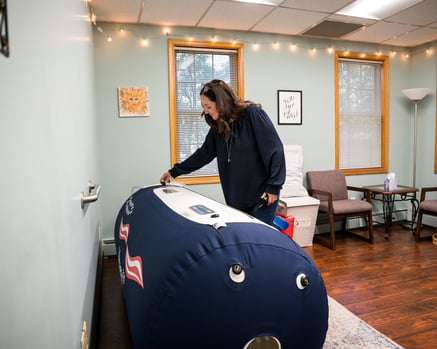Hyperbaric oxygen therapy (HBOT) is a medical treatment that involves breathing pure oxygen in a pressurized chamber. The concept behind HBOT is to increase the amount of oxygen dissolved in the bloodstream, allowing it to reach areas of the body with limited blood flow or damaged tissues.
Hyperbaric oxygen therapy has been used for decades to treat various medical conditions. Historically, it started off as an effective in treating decompression sickness, a condition commonly experienced by scuba divers who ascend too quickly, as well as carbon monoxide poisoning. Now, HBOT is being used to improve conditions such as non-healing wounds, radiation injuries, certain infections, and specific types of tissue damage caused by reduced blood supply.

HBOT for Chronic Pain
A study published in the Journal of Pain Medicine in 2018 examined the effects of HBOT on patients with complex regional pain syndrome (CRPS), a chronic pain condition. The findings revealed that HBOT significantly reduced pain intensity and improved physical functioning, sleep quality, and overall quality of life in individuals with CRPS [1]. Another study published in the journal Regional Anesthesia and Pain Medicine in 2020 evaluated the efficacy of HBOT in treating refractory chronic low back pain. The results demonstrated a significant reduction in pain scores and an improvement in functional status among the participants who received HBOT [2].
So how does HBOT really work to soothe pain? One proposed mechanism is the modulation of inflammation. A study published in the Journal of Oxidative Medicine and Cellular Longevity in 2020 explored the role of HBOT in reducing neuropathic pain. The findings indicated that HBOT exerted its analgesic (pain-relieving) effects by modulating oxidative stress, neuroinflammation, and neuronal apoptosis (neuron death) in the nervous system [3]. Another study published in the Journal of Pain Research in 2019 investigated the impact of HBOT on chronic musculoskeletal pain. The researchers reported that HBOT significantly decreased pain intensity and improved functional capacity by reducing inflammatory markers and enhancing tissue oxygenation [4].
Moreover, HBOT has been found to promote angiogenesis, the formation of new blood vessels. These effects can aid in tissue repair and regeneration, especially in chronic pain conditions associated with tissue damage or poor blood supply [5].
What to Expect
During a hyperbaric oxygen therapy session, the patient typically lies down or sits inside the chamber. When a person enters the chamber and the pressure is increased, the lungs can take in a significantly higher concentration of oxygen. Under these conditions, the oxygen dissolves in the blood plasma and can reach areas of the body that are difficult for red blood cells to access. The pressure is gradually increased, and the person breathes pure oxygen through a mask or hood. The treatment session usually lasts for about 60-90 minutes, and multiple sessions may be required depending on the condition being treated.
Considerations
While hyperbaric oxygen therapy offers potential benefits, it is important to note that it may not be suitable for everyone. Certain medical conditions, such as untreated pneumothorax (collapsed lung) or certain types of lung diseases, can be contraindications for HBOT.
Takeaways
- HBOT is a specialized medical treatment that utilizes increased atmospheric pressure to deliver high levels of oxygen to the body.
- Research studies demonstrate the positive effects of HBOT in reducing pain intensity, improving functional status, and enhancing quality of life in patients with various chronic pain conditions.
- The underlying mechanisms involve the modulation of oxidative stress, neuroinflammation, and tissue oxygenation.
Questions? Call PIH at 609.512.1468 for more information.
References
[1]: Xu, T., et al. (2018). Hyperbaric oxygen therapy for complex regional pain syndrome: a systematic review and meta-analysis of randomized controlled trials. Pain Medicine, 19(6), 1198-1209.
[2]: Zheng, S., et al. (2020). Effectiveness and safety of hyperbaric oxygen therapy for chronic low back pain: a randomized, sham-controlled, double-blind trial. Regional Anesthesia and Pain Medicine, 45(11), 862-868.
[3]: Cai, Y., et al. (2020). Hyperbaric oxygen therapy relieves neuropathic pain by inhibiting oxidative stress and neuronal apoptosis in the spinal cord. Oxidative Medicine and Cellular Longevity, 2020, 1851742.
[4]: Barrett, J. P., et al. (2019). Hyperbaric oxygen therapy for chronic musculoskeletal pain: a randomized double-blind placebo-controlled trial. Journal of Pain Research, 12, 3061-3073.
[5]: Thom, S. R. (2009). Hyperbaric oxygen: its mechanisms and efficacy. Plastic and Reconstructive Surgery, 123(6S), 123S-131S.